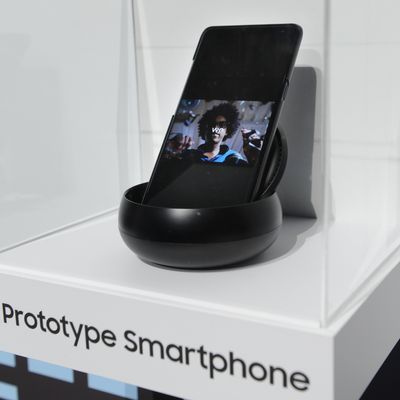
Over the next few years, your smartphone is going to be transformed. Not just around the edges, as we’ve come to expect, but in revolutionary ways: dramatically higher battery life, download speeds a hundred times faster than what we have now, extremely low latency, and the ability for device- and app-makers to radically rethink how they design their products. By 2029, your smartphone may not even be the primary way you interact with the digital world, and you will almost assuredly be using other mobile devices in ways that simply aren’t possible today.
The reason is the data network. Smartphones have greatly improved over the past decade, with sharper screens and better cameras, plus we’ve finally gotten rid of that pesky microphone jack. But the data networks that they run on — 4G and LTE (Long-Term Evolution) — have been largely the same since 2010. That’s about to end, with a new standard, 5G, that will start to roll out in 2019 and hit the masses in 2020 and 2021. On Wednesday, Samsung revealed that a version of its Samsung Galaxy S10 with 5G capabilities will become available in the second quarter of 2019. LG has confirmed it will also be bringing a 5G phone to market in 2019. Huawei has promised that its first 5G phone be available before “the end of June 2019.” And while Apple almost assuredly won’t offer a 5G phone this year, most analysts agree that that will change in 2020.
The next big step: building the 5G networks to connect these 5G devices to.
The Next Generation
At the most basic level, 5G stands for fifth-generation. Ever since cellular networks first appeared, there’s been a new generation about every ten years. 1G was wireless cellular technology that used analog technology to transmit the voice. (It was never made explicitly clear, but Zack Morris was likely using a 1G phone on Saved by the Bell). 2G was largely the same, but it allowed for data to be transmitted: phones using it could send text messages and download emails. 3G brought the internet everywhere — you could suddenly load a web page on your phone without feeling like you were using a dial-up connection. 4G and LTE (with an LTE connection being slightly speedier than a basic 4G connection) rolled out in 2010 and 2011 and made that internet fast. 4G LTE is the reason you can stream Netflix on a park bench, or make a FaceTime call from pretty much anywhere. And 5G will offer much, much faster speeds.
How much faster? Your very best 4G LTE connection can theoretically transmit data at 100 megabits per second (Mbps). A 5G connection could theoretically hit 10 gigabits per second (Gbps) — that’s 100 times faster than the data networks we all use today. On a 4G LTE connection, it takes about six minutes to download a two-hour movie. On a 5G network, that same movie could be downloaded in 3.6 seconds.
If you’re struggling to imagine what you could do with that much speed on your phone — download every movie ever made? — you’re not alone. Carriers, phone manufacturers, researchers, app makers, and engineers of all stripes are trying to figure out the same thing themselves. But 5G networks will need to be built out before it can really be determined.
High Speeds, Tiny Range
5G networks will allow for higher speeds because their antennae will use higher-frequency radio waves than those in the existing 4G LTE infrastructure. The higher the frequency, the more data can be transmitted. The FM radio in your car, for instance, which only transmits sound, operates between between 87.5 to 108.0 megahertz (MHz). 4G networks use frequencies between 700 MHz and 2.5 gigahertz (GHz). Most 5G networks will use much higher frequencies, ranging from 2.5 GHz to 300 GHz.
But thanks to the laws of physics, low-frequency waves travel much further distances than high-frequency waves. (One easy and very old-school example of this: that deep, low-frequency blatt of a foghorn, which can be heard for miles.) The shorter range for 5G networks will require many, many more base stations to be installed than in previous generations of cell coverage. Estimates vary, but Verizon has said it will need five to ten times the number of 5G base stations than it currently uses. The U.S. has 215,000 cell antennae currently installed, so the rough math says you’re looking at anywhere from 1 million to 2.1 million additional 5G units being installed to get nationwide coverage.
“In 2019, it’s only in select markets that the major carriers are going to start deploying 5G,” says Mark Hung, vice president of AI and IoT at Gartner. “It will be very capital-intensive, and they’re gonna to take a while to get deployed.”
In early tests done by Samsung and Verizon, they found they could deliver fixed 5G service at ranges of up to 1,500 feet. Assuming those ranges remain accurate, that would mean you’d need a 5G radio deployed about every two blocks in Manhattan. This is one reason why, in the near-term, 5G will likely only be available in dense urban cores. (And Manhattan likely won’t be getting 5G at first — carriers so far are mainly rolling out 5G networks to cities on the West Coast and in the Sun Belt.)
The suburbs and more rural areas will eventually get 5G as well, though for economic and technological reasons, that will take longer — fewer customers spread over longer distances make for less attractive markets. The carriers that will bring 5G to the countryside will be Sprint and T-Mobile, both of which have invested in lower-frequency 5G, so you get slightly slower speeds in exchange for more range. Sprint has invested in “mid-band,” 2.5 GHz 5G, while T-Mobile is planning to use “low-band” 600 MHz 4G in addition to higher-frequency 5G in denser areas. (In comparison, Verizon and AT&T mostly be using much higher-frequency bands, such as the 28-GHz range. In a statement to New York AT&T pledged it would “have a nationwide mobile 5G footprint using our lower-band spectrum.”)
One thing that may speed up the deployment to less populated areas: the proposed merger between Sprint and T-Mobile. “T-Mobile has committed with the government that they will deploy 5G across many rural markets across the state if they get the approval of the Sprint merger,” says Chris Antlitz, a telecom senior analyst at Technology Business Research, Inc. “So that is a wild card. If that deal goes through, we would have more contiguous 5G availability nationwide.”
There’s also the matter of the issues high-frequency waves have when there’s no direct line of sight between an antenna and a receiver. With 4G LTE networks, this means that if you’re in a parking garage, an elevator, or a tunnel, you are likely to lose your data connection. While 5G base stations can be directed much more precisely than 4G ones, 5G signals can be affected by walls, windows, and even the leaves on trees, leading to the very strange circumstance that you may get faster and more reliable 5G service in winter than in summer, when lush foliage may interfere with your signal.
Autonomous Vehicles: Latency Matters at 65 MPH
While that blazing-fast 5G speed — according to back-of-the-envelope math, you could use a 5G signal to download every movie and TV show on Netflix in under 24 hours — will be what sells 5G at first, its low latency may be the true differentiator.
Latency is the delay between when you send a packet of data off to another phone or server, and when it arrives. Smaller numbers are better here; 4G latency can be as little as 50 ms, but in real-world conditions, the number is often much higher. The mobile trade group GSMA defines 5G as having a latency of 1 ms.
The low latency will come into play in many arenas, one of the most obvious being that of autonomous vehicles (AVs). “For self-driving vehicles, the low-latency capabilities of 5G are essential for the vehicle-to-vehicle and vehicle-to-infrastructure type of communication,” says Hung. “So that’s what 5G is going to make possible.” One of the key promises of AVs is a network of cars all in communication with each other, able to send data back and forth to avoid collisions and smooth out traffic patterns. The generally accepted standard for the most latency you could safely afford in such an AV network is 20 milliseconds. That difference between 100 milliseconds and 1 millisecond of latency is nice when you’re loading someone’s Instagram story or playing Fortnite on your phone; it’s life-saving when you have heavy objects hurtling around highways at 65 miles per hour.
Dumb Devices With Streaming Smarts
Another possibility is the rise of devices that largely act as access points to remote computing centers. While the majority of your phone’s battery life is still eaten up by illuminating your screen, a significant chunk of juice that’s is used by your phone’s CPU (and, increasingly, by discrete graphic processing units and machine-learning chips). But with 5G, your phone could simply use a 5G modem to access a much more powerful computer remotely and send and receive that data at high speeds and with low latency. Presto, you have a phone that suddenly requires much less power draw to do all of the things you need it do.
“You could just have a dumb device with 5G connectivity,” says David McQueen, research director at ABI Research. “All the heavy-lifting computational power is done elsewhere, and you’re just basically walking around with a fairly cheap but connected product.”
The same principle could be applied to a whole constellation of mobile devices. A smartwatch could run for much longer if it didn’t need to keep a high-powered processor onboard. (One could even imagine a smartwatch powered solely by the motion of your wrist, as with self-winding mechanical watches).
Sensors in factories and warehouses could be deployed without needing wired-in power supplies. Warehouses and other industrial applications would also benefit from another key aspect of 5G — the ability of 5G small cells sites to allow vastly more devices to connect than to 4G base station. This means you could have tens of thousands of devices with sensors and 5G antennae all broadcasting information that could be gathered to keep track of everything on a job site. (For the rest of us, it will make not being able to get a signal at a crowded concert a thing of the past.)
One of the real promises of 5G: augmented-reality glasses. One of the main obstacles keeping AR glasses from crossing over from high-tech fantasy into everyday reality are that AR glasses need to carry a significant amount of computing power, making them bulkier and chunkier than what most people would want to wear. If engineers can use 5G networks to offload that onboard computing to the cloud, it would be much easier to make AR glasses lightweight and stylish — all you’d need on the hardware side would be a very simple CPU, a small 5G modem, and a battery.
The downside of all of this, of course, is that the moment you drop off of a 5G network, your dumb devices will lose all their smarts. Making this tradeoff worth it would require showing consumers just how much more battery life they could save (still an open question) and how much cheaper a dumb device that offloads much of it’s computing to the cloud would be (a similarly open question).
A New Age of ISP Competition
Another area where 5G may come into play: delivering high-speed internet into your home. Verizon is already making a play in this area, offering what it calls a 5G Ultra Wideband wireless network. Using a 5G base station, Verizon can beam very fast internet into your home, no coaxial or fiber-optic cable required. AT&T and T-Mobile have also announced plans to enter the same space.
“5G is a game-changer in the internet access space,” says Antlitz. “It’s going to bring a real destructive force to that market that we haven’t quite seen yet, Let’s be real here, the cable guys in many markets across the states are a monopoly.” Current ISPs are able to protect their monopoly status mainly because it’s so expensive to build infrastructure. Trenches have to be dug, cable has to be laid, and occasionally, water mains will be ruptured. 5G base stations aren’t cheap, but compared to laying fiber-optic cable, they’re a rounding error.
The ability of carriers to compete with existing ISPs won’t radically alter the competitive landscape of ISPs — you’re still going to have a few large companies competing for your business. But 75 percent of all Americans live in areas where there’s only one high-speed internet service provider; two or three ISP options will be a vast improvement over the current state of affairs.
So, Should You Buy a 5G Phone? And How Will 5G Change Your Life?
If you live in one of the cities where Verizon is rolling out mobile 5G, have money to burn, and like the idea of getting a taste of the future right now, go for it.
For everyone else, I’d say play the waiting game. Until a significant number of U.S. cities have 5G connection, and until a significant number of phones hop on 5G networks, downloading a movie in three seconds will be a neat trick, but the technology won’t change your life. But as 5G networks spread over the next two years, and Apple offers up its own 5G-capable phone (likely in the fall of 2020), that will change.
Companies both large and small are making bets right now on what 5G will allow us to do in areas ranging from medicine to e-commerce (think doctors performing surgery remotely or warehouses being able to track where every single item inside it is in real time), but the reality is that until 5G is widely deployed and has mass usage, we won’t know what 5G will actually unleash on the world.
“Many of these applications aren’t gonna pop up tomorrow. It’s gonna be over time. And this is true of every cellular generation,” says Emanual Kolta, a 5G research analyst at ABI Research. “The technical specs are always ahead of what the existing needs are. When we started to have 4G networks in 2010 and 2011, we didn’t know about Uber or Instagram or the rest. First we had the network, and then a lot of talented, smart people in Silicon Valley started to build applications based on these technologies.”
In 2019, 5G will a buzzword you’ll hear increasingly often, but it’s not likely to change anything in your life. By 2029, it’ll be so ingrained into your daily life you’ll have trouble remembering when your phone (or watch or eyeglasses or smart mirror) used to be slow to respond, or unable to stream such high-resolution video, and nerds will be salivating over the when 6G data networks will finally arrive. And sometime in between, someone will come up with something that will fundamentally turn how we live on its head all over again.





























